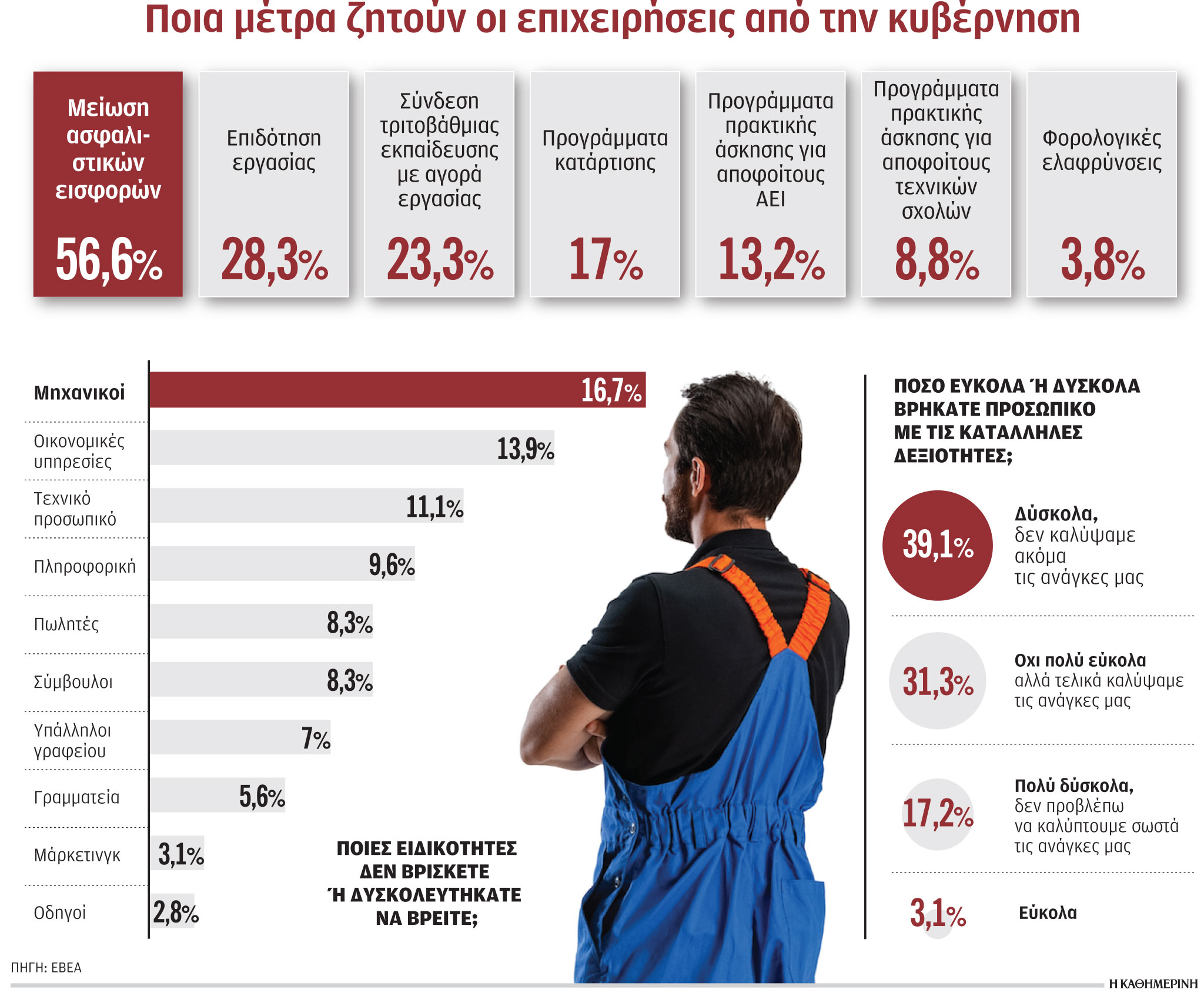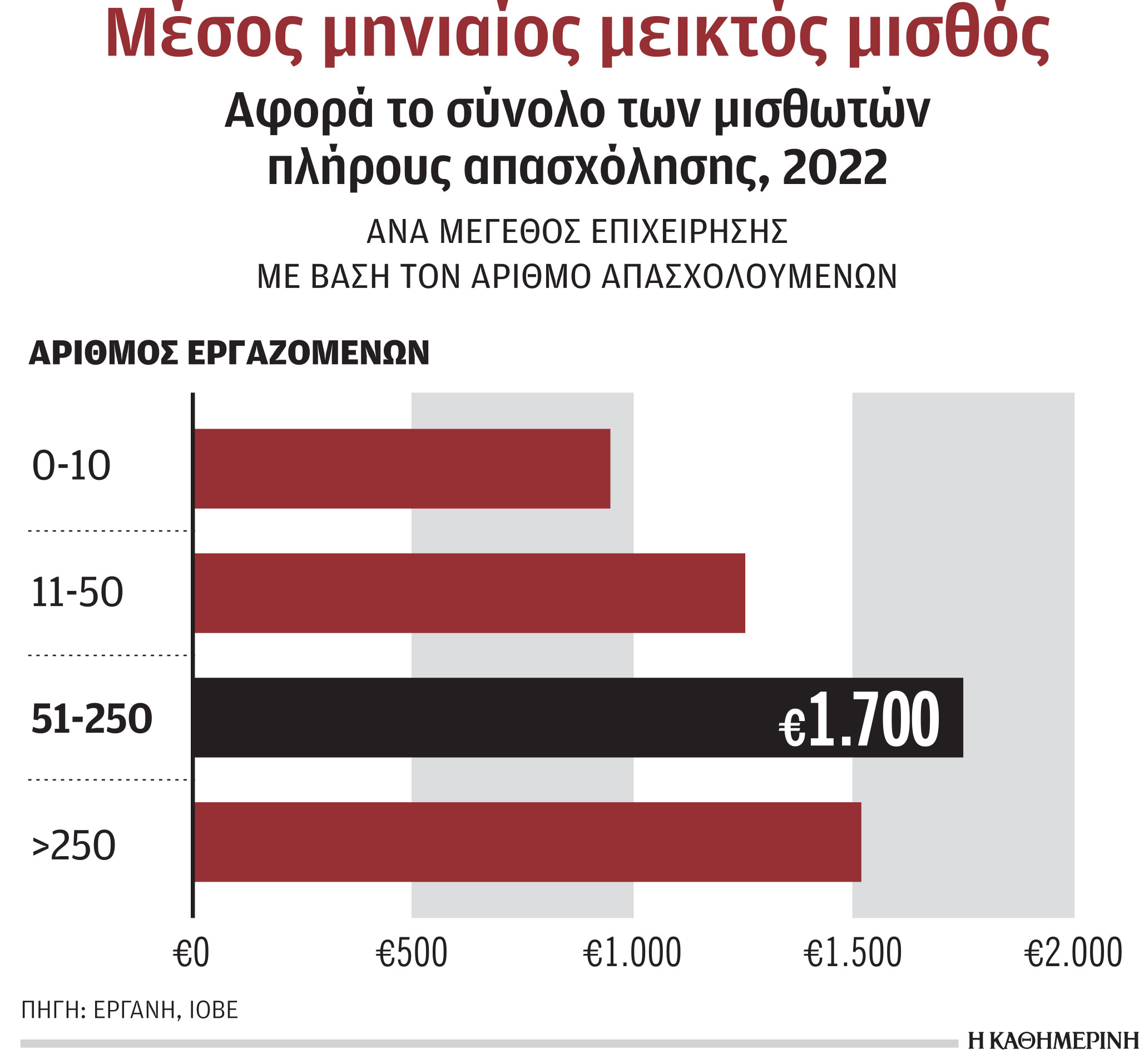
What prevents more than half a million unemployed and Greek businesses… from meeting, as a result of which the unemployment rate, although declining, remains at a significantly high level (10.9% in March according to ELSTAT) and almost 9 out of 10 enterprises to announce that they are looking for – in vain – workers? Why do even those companies that started recruiting last year say that at a percentage of more than 30% it was difficult for them to find staff, and 17.2% believe that the degree of complexity is so great that their needs will not be met? met correctly? And why are enterprises looking not only for highly qualified and qualified managers, but even for unskilled workers, and in general to cover the needs in all branches of domestic economic activity? And finally, why don’t businesses raise wages to meet their needs?
The lack of “talent”, the mismatch between supply and demand in the labor market, the many vacancies along with high unemployment – many forms of the same complex problem that has been observed at the global level for at least a decade, and recently (the last two years) very strongly manifested itself in our country. This is the result of many trends and distortions in labor markets, ie. in various industries and professions, in the economy, in the educational system and in society, which “K” seeks to illuminate today with the help of economists who come from their position in daily contact with the problem.

As Christos Gulas, Director General of the Labor Institute and the GSEE Education Policy Development Center, explains in an interview with K, the existence of a mismatch between supply and demand in labor markets is a measurable fact that is difficult to dispute, although there is a simplification of parameters that significantly limit the possibilities of solving the problem, through the development of appropriately targeted public policies. According to Mr. Gula, companies’ difficulty in finding staff does not necessarily mean that workers do not have the necessary skills. Jobs available in most manufacturing industries do not require a high level of skill, with the result that a much larger proportion of workers feel that their skills are undervalued and underpaid, and in the case of the unemployed, are ignored by firms whose production structure and organization is based on low-cost intensive labor.
The CEO of INE GSEE also points out that the classic motivation crisis that really plagues companies that invest in low-level, seasonal products and services is the mismatch between supply and demand of skills. Thus, of course, Mr. Gulas points out, the existing skills of employees are underestimated, and the services provided are degraded, which is fatally focused on the direction of quick and easy profitability. The third aspect of the problem, according to the director of INE, concerns companies’ limited investment in research and development and their even more limited participation in the continuous professional training of their employees. And, finally, the fourth, no less important parameter that he notes is the absence of sectoral labor contracts that could turn into roadmaps for productive business development.
Apprenticeships and internships do not work satisfactorily, and career guidance is lacking.
The economic growth observed over the past four years with the creation of 300,000 new jobs has exacerbated the problem, as it has increased the demand for certain industries and specialties, which naturally increased mobility in the labor market, as well as the choice of workers, indicates “K”, the director of the employment sector and labor market SEV Christos to John. And stresses that the impossibility of filling vacancies is aggravated by the problem that tends to acquire structural characteristics, undeclared work, especially in low-skilled and low-paid jobs. Of course, Mr. Ioannou also highlights the big problem that higher education also produces many unqualified graduates who work elsewhere, and technological education is also not enough. “Institutions that link education with production and facilitate the transition of young people from education to employment, such as vocational education, apprenticeships and internships, are not working satisfactorily, and vocational guidance is lacking for young people and their families, as well as for the education system,” emphasizes Mr. – Mr. John. In addition, in regulated technical licensed professions, education is ineffective, the curriculum does not keep pace with the development of technology, and licensing does not work.
According to Mr. Ioannou, factors such as:
• Demographics that are slowly but surely reducing the available labor force.
• Increasing the proportion of inactive potential of working age, for example, women who face significant difficulties in retaining the labor market.
• The system of lifelong education – education, which for many years has been a self-serving “bubble” of absorption and waste of resources and opportunities.
And, as the director of employment at BSE characteristically concludes, “It is not enough for an employee that the company wants him, that his knowledge, his experience and his skills make him, he must also want the company that wants him.” In other words, companies also bear a significant share of the responsibility.

Most young people under 25 receive up to 500 euros per month.
The “small” Greek economy, which is 90% based on consumption, as well as the high cost of living in Greece, combined with the particularly low wages and working conditions in our country, as they were formed mainly after a 10-year fiscal crisis, are, according to the scientific director of the National Center for Social Research Ilyas Kikilia, the main reasons for the phenomenon of mismatch between supply and demand in the domestic labor market.
Although we have the most educated generation ever to live in the country, most of the jobs they provide are “unreliable,” Mr Kikilia said. Nearly half of the new jobs created each year in recent years are part-time and shift work. Even the EFKA data, Mr Kikilias points out, shows that most young people under 25 earn up to 500 euros a month because they are part-time workers, as well as young people aged 25 to 34. the old do not receive a salary of more than 800 euros. At the same time, the purchasing value of the minimum wage fell by 40% due to high inflation, while it was found that in Greece 49% of the average wage is spent on the purchase of essentials, and in Italy 27%. % is spent, and in France 19%. To the high cost of living, where 1/3 of the salary is spent on food and 1/3 on energy, we must add the fact that many young people do not have their own housing, so they either live with their parents or pay significantly high rents. And also excessive taxation, as the EKKE research director considers it significant that in 2022 tax revenues were 5 billion euros more than budgeted tax revenues, with 2/3 of total revenues coming from consumption taxes.
In this context, the fact that some workers are demanding higher wages than what is required to fill the job, Mr. Kikilias notes, can in no way be considered an “excessive demand”. On the contrary, he believes that the wages offered are not enough to cover the highest cost of living, even more so if we add to it the private spending on health and education, which puts our country among the OECD champions. Complementing the picture are significant shortcomings in labor relations, with a lack of collective bargaining agreements, menial jobs, workers with irregular working hours, as well as in some industries aimed at temporary profit, a jungle of working conditions and in all these, an almost complete lack of control on labor market.
Of course, Mr. Kikilias also highlights the problems associated with the shortage of both technical specialties, pointing out that technical education in our country has been destroyed to such an extent that OAED apprenticeship schools seem to many young people of 18 years of age as an important way out of professional deadlock. , as well as in high-level specialties, when higher education does not keep pace with the development of its curricula.
Artificial intelligence
The shortage problem will persist in the coming years. Experts are sounding the alarm, pointing out that serious initiatives are required both on the part of representatives of industries and business, and on the part of the state, since reforms are needed in the education system aimed at bridging the gap between education and vocational training, but also in the most efficient functioning labor market. What is required, as Mr. Ioannou points out, is a combination of human intelligence, knowledge and technology, with the help of even artificial intelligence. A typical example is CEDEFOP in Thessaloniki, which uses the Skills-OVATE tool to analyze skills. This is a tool that analyzes the content of advertising, the demand for jobs throughout Europe. Something similar can be used directly as a mechanism for diagnosing the needs and trends of the labor market in professions and skills on the part of the state and departments.
Source: Kathimerini
Lori Barajas is an accomplished journalist, known for her insightful and thought-provoking writing on economy. She currently works as a writer at 247 news reel. With a passion for understanding the economy, Lori’s writing delves deep into the financial issues that matter most, providing readers with a unique perspective on current events.